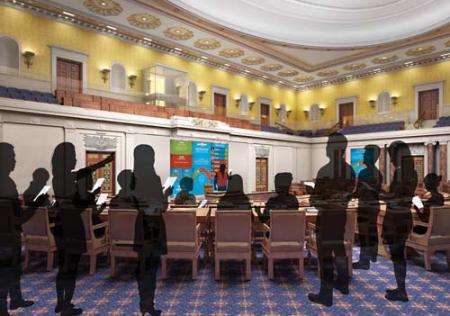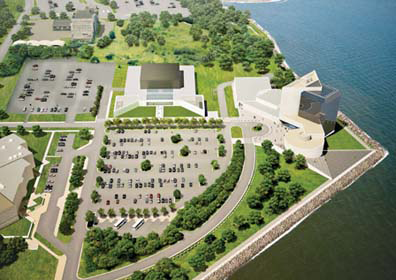September 11, 2013
Can you imagine taking the floor of the United States Senate to debate the morality of a US strike on Syria, the merits of a farm bill, or the confirmation of a new US Supreme Court justice?
By this time next year, you – and your family – might be able to do just that. And you won’t need to impersonate Ed Markey or Elizabeth Warren— or even go to Capitol Hill— to weigh in on issues of the day. In fact, you’ll be able to drive, ride, or just walk to Columbia Point, where the Edward M. Kennedy Institute for the United States Senate is now rising along the crest of a hill that overlooks Dorchester Bay.
Construction work on the 62,000-square-foot structure on the UMass Boston campus is right on schedule for its planned opening next year. The $78 million facility, designed by architect Rafael Vinoly, is being built next door to the existing John F. Kennedy Presidential Library and Museum.
Katherine Craven, the executive director of the UMass Building Authority, which will lease the space to the Institute, says that work on the Institute is on track for a May 2014 “substantial completion” date, with tentative plans for a fall 2014 opening. “The steel is all up and now we are focused on the interior,” she said. “We are on schedule and we’re starting to integrate in the exhibits.
“We’re proud of it,” Craven said. “The base building is a pretty high-end design and it’s a beautiful monument to the late senator. I think he’d be pleased with the architecture and how it fits in with the presidential library next door. He picked this location back in 2003. It’s a pretty amazing thing for Dorchester to be home to the presidential library and now this first-of-its kind institute.”
Andrew Tarsy, past executive director of the Anti-Defamation League’s New England region and a former civil rights trial attorney for the US Department of Justice, serves as the Institute’s executive director. He and his team are currently working out of temporary office space in downtown Boston, where they are busy finalizing details of the Institute’s programming and exhibit halls.
The Institute will house a replica of Senator Kennedy’s office that will include his actual desk, books, and gifts presented to the senator through the years. Still, Tarsy cautions, the Institute is not intended to stand as a monument to Ted Kennedy alone. In fact, the senator’s archive will not even be stored at the Institute, but rather at the JFK Library next door. “It’s deeply connected to his passion and vision about what it means to engage in the public square. But this is not supposed to be about one person,” explains Tarsy. “Senator Kennedy wanted people to love the Senate and democracy and debate as much as he did. He hoped the experience would cultivate and inspire.”
The Institute aims to fulfill Kennedy’s vision by creating a space that won’t be bound by the constraints of a traditional museum. Instead of fixed exhibits stacked with artifacts and mannequins, the Institute will tell the Senate’s story by projecting images and words on its walls. This approach will allow for the space to be reconfigured easily for special events and gatherings without any disruption. It will also allow for more dynamic storytelling that can be changed to reflect special events and themes, past and present.
 US Senate comes to Dorchester: A rendering shows the Edward M. Kennedy Institute for the United States Senate, presently under construction on the Columbia Point campus of UMass Boston. The centerpiece of the building is a 10,000 square foot “representation” of the actual Senate chamber, where visitors can participate in interactive debates. Images courtesy Edward M. Kennedy Institute for the United States SenateThe centerpiece of the Institute’s indoor space will be its signature fixture: a 10,000- square-foot “representation” of the Senate chamber itself, complete with desks, chairs, upstairs galleries, and the rostrum. It will serve as the main event for visitors, who will be guided through the Institute’s “chamber surround” with an interactive, tablet device.
US Senate comes to Dorchester: A rendering shows the Edward M. Kennedy Institute for the United States Senate, presently under construction on the Columbia Point campus of UMass Boston. The centerpiece of the building is a 10,000 square foot “representation” of the actual Senate chamber, where visitors can participate in interactive debates. Images courtesy Edward M. Kennedy Institute for the United States SenateThe centerpiece of the Institute’s indoor space will be its signature fixture: a 10,000- square-foot “representation” of the Senate chamber itself, complete with desks, chairs, upstairs galleries, and the rostrum. It will serve as the main event for visitors, who will be guided through the Institute’s “chamber surround” with an interactive, tablet device.
By offering visitors a “tangible way” to understand the inner workings of the body, along with its history, the Dorchester facility will be unlike any other institution in the country, says longtime Senate historian Richard Baker.
“The recreation of the model of the chamber strikes me as a terrific learning tool. No one, unless they are elected to the Senate, has the privilege of standing on that floor. It’s magnificent,” says Baker, who serves on the Institute’s content advisory committee.
Baker was instrumental in the creation of the visitor’s center at the Capitol Building, a $600-million facility that opened in 2008. He says that the Kennedy Institute has the advantage of learning from the best practices of that effort. As an advisor from the earliest stages of the Institute’s planning, Baker sees his roles as ensuring that information presented is “valid and accurate” and that the Institute’s keepers are “asking the right questions.”
Tarsy says that there will actually be three different visitor experiences inside the building, and all three can overlap. Some visitors will tour the 10,000 square feet of exhibition space that will surround the two-story chamber while others are immersed in a Senate “debate” inside the main hall. Still others may be part of a longer “simulated” Senate experience akin to a model-United Nations exercise.
Docents, or “student ambassadors”, will help expedite tours through the exhibit space. But each visitor will be given a tablet device that will run a pre-loaded “sim” — or “simulated Senate module.” A sample sim might guide a group through the legislative process on a particular bill or review a sequence of historical events. The open-platform software will allow new sims to be developed and loaded anytime to deal with evolving issues or crises.
The intent, Tarsy says, is to create “individual and collaborative experiences that activate visitors’ understanding of the Senate and catalyze their commitment to public service.”
Tarsy and his team are particularly interested in making sure that middle and high school students make the best use of the Institute during their visits, whether they be a one-day field trip variety or longer duration ‘Model UN’-style camps during summer break.
 Edward M. Kennedy Institute for the US Senate aerial viewThe Institute has enlisted a committee of teachers to advise on their plans for sims and other programming. Neema Avashia, who teaches civics to eighth graders at Dorchester’s Dever-McCormack School, is one of those who are meeting monthly to consult with the EMK Institute’s staff on a range of topics. The teachers are engaged with details both mundane —like how to best to route school buses on the property— and sophisticated – like how to create modules that tackle delicate historical subject matter.
Edward M. Kennedy Institute for the US Senate aerial viewThe Institute has enlisted a committee of teachers to advise on their plans for sims and other programming. Neema Avashia, who teaches civics to eighth graders at Dorchester’s Dever-McCormack School, is one of those who are meeting monthly to consult with the EMK Institute’s staff on a range of topics. The teachers are engaged with details both mundane —like how to best to route school buses on the property— and sophisticated – like how to create modules that tackle delicate historical subject matter.
The process of making law is a lot more complicated than the animated “School House Rock” anthems that primed 20th-century teens on the machinations of Capitol Hill. The Institute, Avashia says, will immerse students and older visitors in the “complex and layered” experience, using hand-held tablets, projected images, and real-time “sims” to bring Washington to Columbia Point. As a result, a typical field trip to the Institute will require that both students and their teachers do their homework before their arrival.
"I don’t think this is the kind of experience you’d put kids into cold,” explains Avashia. “I actually think they would not want that to be what happens.”
No matter the visitor’s age, Baker thinks that everyone who steps into the building will be fascinated by the presentations, which promise to be unlike any thing they’ve seen before.
“For any comparable education institution that tries to help people understand how Congress works, it’s a challenge right off the bat,” Baker said. “But the Kennedy Institute brings resources that aren’t available to most and they have the breadth of vision that just doesn’t exist anywhere else either. They’ve done their legwork.”
UMass-Boston deans, led by Provost Winston Langley, are also working with the Institute to develop educational programming and classroom space in the building, according to Chancellor Keith Motley, who serves on the Institute’s board.
“What I’ve enjoyed most is seeing how far the institute has come — both physically, in the form of its new building, and programmatically. I think both the university and the Institute have benefited from the collaboration that we’re all committed to. We’re looking forward to a long and fruitful relationship that will benefit our students, Boston, the commonwealth, and beyond,” Motley said.
Villages:
Topics:


